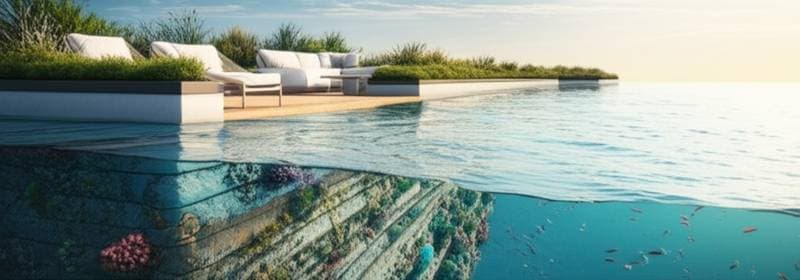9 Living Seawall Ideas for an Eco-Friendly Defense Against Coastal Erosion
Coastal living offers ocean views, salt air, and the rhythm of waves. Property owners near water confront coastal erosion as a persistent challenge. Traditional concrete seawalls halt erosion yet disrupt habitats and reflect waves, which accelerates damage elsewhere.
Living seawalls address this issue. These systems integrate structural durability with ecological advantages. They form a dynamic boundary between land and sea, fostering marine life, purifying water, and stabilizing shores through natural processes. Consider a living seawall as both protective barrier and vibrant habitat.
This guide explores effective living seawall ideas. Each design safeguards property while promoting biodiversity. Examples range from modular panels resembling rock formations to native plants and oyster reefs. These approaches demonstrate collaboration between engineering and nature.
Coastal homeowners, landscape designers, or enthusiasts of sustainable protection will find value in these nine concepts. They provide insights for constructing or advocating resilient shorelines.### 5. Native Seaweed Cultivation for Added Protection
Seaweed and kelp at the seawall base dampen waves and capture sediments. They offer nourishment and refuge for marine organisms.
How to Start:
- Secure biodegradable ropes or mesh at the base.
- Introduce local seaweed seeds.
- Observe development and refresh mesh periodically.
Pro Tip: Opt for species like giant kelp or surfgrass adapted to regional conditions. This method proves economical with little upkeep after maturity.
[Image: Seaweed growing along a living seawall underwater]
6. Perforated Designs to Mimic Natural Shorelines
Perforated seawalls permit water passage, easing structural stress and enabling organism movement.
Advantages:
- Lessens base scouring
- Improves circulation
- Cuts reflected wave force
Pro Tip: Pair perforations with rough textures for optimal ecology. Employ rust-proof reinforcements for durability.
[Image: Perforated concrete seawall with water flow openings]
7. Recycled Material Integration for Sustainable Build
Incorporate recycled plastics or tires into seawall cores. These materials provide strength while diverting waste from landfills.
Benefits:
- Reduces environmental footprint
- Offers cost savings on raw materials
- Supports circular economy principles
Implementation Steps:
- Shred and bind recycled aggregates.
- Encapsulate in protective geotextile.
- Integrate with living facades.
Pro Tip: Verify material compatibility with marine exposure. This approach suits budget-conscious projects in urban coastal settings.
[Image: Seawall section using recycled plastic aggregates]
8. Modular Textured Panels for Easy Installation
Interlocking panels with irregular textures simulate rocky shores. They facilitate quick assembly and attachment of marine growth.
Benefits:
- Simplifies construction and retrofitting
- Encourages colonization by algae and barnacles
- Adapts to varying site conditions
Implementation Steps:
- Select panels matching local rock types.
- Secure with non-toxic anchors.
- Seed with initial organisms if needed.
Pro Tip: Use lightweight composites for easier handling. Panels allow section-by-section upgrades as ecosystems develop.
[Image: Modular textured panels forming a living seawall]
9. Hybrid Mangrove Systems for Tropical Coasts
Mangrove plantings integrated into seawall designs trap sediments and buffer storms. Prop roots stabilize structures in suitable climates.
Benefits:
- Accelerates shoreline accretion
- Provides carbon sequestration
- Hosts diverse wildlife
**Implementation Steps:**n1. Create planting pockets in wall bases.
2. Use red or black mangrove propagules.
3. Protect from herbivores during early growth.
Pro Tip: Ideal for subtropical regions; combine with breakwaters in high-energy sites. Mangroves expand protective reach over years.
[Image: Mangrove-integrated living seawall in a tropical setting]
Planning Advice for a Successful Living Seawall
Careful preparation ensures seawall effectiveness. Follow these steps for integration of structure and ecology.
- Consult Local Experts: Collaborate with marine biologists and coastal engineers versed in regional tides and species.
- Check Regulations: Obtain permits for shoreline alterations in regulated zones.
- Monitor Regularly: Inspect plant vitality and stability periodically as the system develops.
- Incorporate Community Input: Involve nearby residents or groups for shared maintenance and biodiversity tracking.
- Adapt to Changes: Adjust elements based on shifting erosion or environmental patterns.
[Image: Team inspecting a coastal living seawall installation]
Frequently Asked Questions
What is a living seawall?
A living seawall merges engineered barriers with natural features like plants, shells, or rough surfaces. It curbs erosion, aids marine habitats, and elevates water quality.
How does a living seawall reduce coastal erosion?
Designs absorb waves rather than reflect them. Elements such as oysters, vegetation, and textured surfaces secure sediments and restore shorelines organically.
Is a living seawall more expensive than a traditional one?
Upfront expenses range from $200 to $600 per linear foot, comparable or modestly higher. Long-term ecological gains and lower upkeep often yield savings.
Can I retrofit an existing seawall into a living seawall?
Yes. Attach textured overlays, oyster setups, or greenery to upgrade without demolition.
How long does a living seawall last?
Proper care and growth support decades of service. Durability hinges on materials, locale, and ecological harmony.
Are living seawalls suitable for all coastal environments?
They excel in protected or moderate-exposure sites. High-wave areas benefit from hybrids blending living and reinforced elements.
Building Resilient Shores for the Future
Living seawalls transform coastal defense into opportunity for restoration. They safeguard properties while revitalizing ecosystems. Adopt these ideas to contribute to healthier oceans and enduring shorelines.

